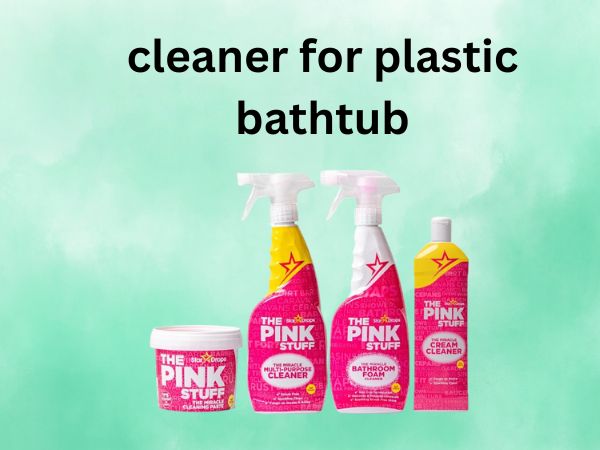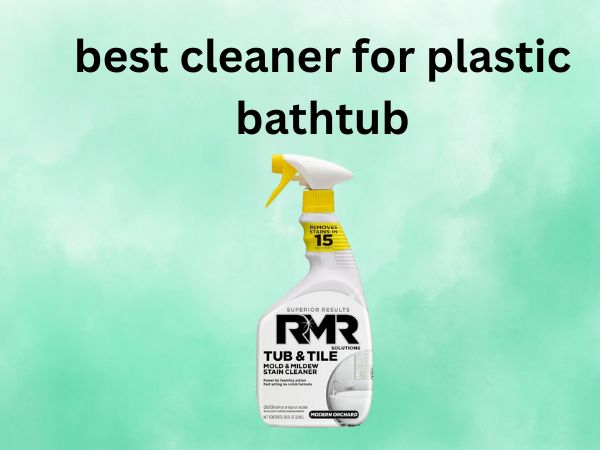What Is The Best Cleaners for Plastic Bathtubs [In 2025]
Are you tired of fighting with stubborn stains, soap scum, and mildew in your plastic bathtub? I’ve been there too, scrubbing away with generic cleaners only to see minimal results. The truth is, plastic bathtubs require special care to maintain their shine and prevent damage. After testing dozens of products, I’ve narrowed down the five best cleaners that will transform your plastic bathtub from grimy to gleaming.
In this comprehensive guide, I’ll walk you through the top products that actually work, explain their pros and cons, and share expert tips to keep your bathtub looking brand new. Whether you’re dealing with hard water stains, mold, or everyday grime, you’ll find the perfect solution here.
Table of Contents
Top 5 Cleaners for Plastic Bathtubs Review
After extensive research and testing, these five cleaners have proven most effective for plastic bathtubs, each with their own strengths for different cleaning challenges.
Stardrops – The Pink Stuff Miracle Cleaning Bundle
The Pink Stuff has developed something of a cult following, and for good reason. This versatile cleaning bundle includes a paste, multi-purpose spray, bathroom foam spray, and cream cleaner, making it a complete solution for your plastic bathtub.
What makes The Pink Stuff special is its ability to tackle tough grime without harsh chemicals. The mild abrasive formula in the paste is just enough to remove stubborn stains without scratching delicate plastic surfaces. Meanwhile, the bathroom foam spray is perfect for vertical surfaces where you need the product to cling rather than run off.
I was particularly impressed with how The Pink Stuff handled soap scum on my shower doors – a problem that typically requires significant scrubbing with other products. With The Pink Stuff, the scum wiped away with minimal effort.
Pros and Cons of The Pink Stuff
Pros:
- Versatile bundle with multiple formulations for different cleaning needs
- Effective on tough grime without harsh scrubbing
- Pleasant lemon scent that isn’t overwhelming
- Works on multiple bathroom surfaces beyond just the bathtub
- No harsh chemical smell during or after cleaning
- Natural ingredients make it safer for households with children and pets
Cons:
- The paste requires more effort to apply compared to spray formulas
- May need multiple applications for extremely stubborn stains
- Slightly more expensive than single-solution cleaners
- The paste can dry out if not properly sealed after use
One user reported: “I purchased this set because I was told that the paste would clean my oven easily without the harsh chemical smells. I was amazed at how easily it went on and cleaned… I will definitely keep this product in stock for other cleaning jobs around the house.”
RMR Tub and Tile Cleaner
When mold and mildew are your primary concerns, RMR Tub and Tile Cleaner stands out as an industrial-strength solution that requires minimal effort. This no-scrub foam cleaner clings to vertical surfaces and does the hard work for you.
What sets RMR apart is its fast-acting formula specifically designed to target mold and mildew stains. For plastic bathtubs where mold tends to grow in textured areas or along caulking, this cleaner penetrates deeply to eliminate discoloration at the source.
The Modern Orchard scent attempts to mask the chemical smell, though it’s worth noting that this is one of the stronger-smelling options on our list.
Pros and Cons of RMR Tub and Tile Cleaner
Pros:
- Extremely effective at removing mold and mildew stains
- No-scrub formula saves time and effort
- Fast-acting – begins working instantly
- Made in the USA with high-quality ingredients
- Works on grout, tile, and plastic surfaces throughout the bathroom
Cons:
- Strong chemical smell requires good ventilation
- May require protective equipment like gloves and possibly a respirator
- Not ideal for daily cleaning due to strength of formula
- May require repeat applications for deeply embedded stains
- More specialized for mold rather than being an all-purpose cleaner
A satisfied customer noted: “This is the best product for removing mold. It works better than your Lysol, Clorox, cleaning vinegar, and other cleaning supplies for mold removal. This works very fast. No scrubbing required. Spray generously, leave it for 2 minutes to work its magic, and rinse thoroughly.”
BioClean Hard Water Stain Remover
If mineral deposits and hard water stains are your bathtub’s main enemies, BioClean Hard Water Stain Remover deserves a spot in your cleaning arsenal. This professional-strength cleaner comes in a cream form with a mild mint scent that’s refreshing compared to the harsh chemical smell of many competitors.
What makes BioClean stand out is its effectiveness on years of built-up hard water stains – the kind that make plastic bathtubs look permanently dirty no matter how much you clean them. Its biodegradable formula is also a plus for environmentally-conscious consumers.
I’ve found that BioClean works best when applied with a fine steel wool pad on really tough stains, though care must be taken to use very fine steel wool to avoid scratching the plastic surface.
Pros and Cons of BioClean Hard Water Stain Remover
Pros:
- Extremely effective on hard water stains and mineral deposits
- Pleasant mint scent instead of harsh chemical smell
- Biodegradable formula is better for the environment
- Works on multiple surfaces including stainless steel
- Requires minimal scrubbing for most stains
- Professional-grade formula for industrial-strength cleaning
Cons:
- Cream form requires more effort to apply evenly compared to sprays
- May need steel wool for tougher stains, requiring caution to prevent scratching
- More expensive than some everyday cleaners
- Specialized for hard water rather than a complete cleaning solution
- May require multiple applications for severe staining
One enthusiastic user shared: “I used this product with some fine steel wool pads to clean built-up hard water and soap film on the glass shower enclosure and it is the best product I have ever used!! I have tried just about every product that promised results only to be disappointed so many times… This product is a game changer!”
GlassGuard Miracle Mold Cleaner Gel
GlassGuard Miracle Mold Cleaner Gel takes a different approach to bathroom cleaning with its thick gel formula that clings to surfaces for extended contact time. This makes it particularly effective for targeted cleaning of problem areas in plastic bathtubs, especially mold along caulking or in corners.
What distinguishes GlassGuard is its ability to work without scrubbing – simply apply the gel, wait 2-5 hours, and rinse away. This extended dwell time allows the formula to penetrate deeply into stains, making it ideal for those hard-to-clean areas where mold seems permanent.
The unscented formula is a significant advantage for those sensitive to strong cleaning odors, though it does have a mild chlorine smell similar to a swimming pool.
Pros and Cons of GlassGuard Miracle Mold Cleaner
Pros:
- Highly effective at removing mold stains without scrubbing
- Gel formula sticks to vertical surfaces without dripping
- No added fragrance makes it suitable for those with sensitivities
- Works well on grout, glass, and plastic surfaces
- Simple application process – apply and walk away
Cons:
- Requires long waiting time (2-5 hours) for best results
- Limited effectiveness on silicone caulk according to some users
- More expensive per ounce than some competitors
- Specialized for mold rather than being an all-purpose cleaner
- May require multiple applications for severe mold problems
A customer reported dramatic results: “I wish I had taken a before photo but I honestly wasn’t expecting too much. The old moldy grout in my new house is from 1968 and has not been attended to in years- it was really bad… By the time I washed it off after 5 hours my grout looked BRAND NEW I’m not kidding like bright white.”
Clorox Bathroom Ultra Foamer
For those seeking an easy-to-use, everyday cleaner for plastic bathtubs, Clorox Bathroom Ultra Foamer delivers excellent results with minimal effort. This innovative aerosol-free foaming cleaner comes with both a spray bottle and a refill, making it an economical choice for regular maintenance.
What makes the Clorox Bathroom Ultra Foamer stand out is its ability to remove 100% of soap scum while reaching into corners and crevices where grime often accumulates in plastic bathtubs. The foam clings to surfaces, allowing the cleaner to work effectively before rinsing.
I appreciate the reusable trigger mechanism, which reduces plastic waste compared to buying completely new bottles each time. The fresh scent is pleasant without being overwhelming, making this a good choice for frequent cleaning.
Pros and Cons of Clorox Bathroom Ultra Foamer
Pros:
- Removes 100% of soap scum according to manufacturer
- Foam formula reaches cracks and tight spaces effectively
- Aerosol-free design with reusable trigger reduces waste
- Pleasant fresh scent that isn’t overpowering
- Economical with included refill bottle
- Gentle enough for regular use on plastic surfaces
Cons:
- Some users report issues with the spray trigger mechanism
- More of a mist than a true foam according to some reviews
- Not specialized for tough stains like hard water or severe mold
- May require some scrubbing for more stubborn dirt
- Not as powerful as some specialized cleaners for tough problems
A satisfied user commented: “This cleaner is very good! It removes dirt and soap scum easily. The fresh smell is nice, and my bathroom looks very clean. I like that it comes with a refill. Will buy again!”
Understanding Plastic Bathtubs and Their Cleaning Challenges
Before diving into the best cleaners, it’s important to understand what makes plastic bathtubs unique and why they need special cleaning attention.
Common Issues with Plastic Bathtubs
Plastic bathtubs, often made from acrylic or fiberglass, are popular for their affordability and lightweight nature. However, they come with their own set of cleaning challenges:
- Porosity: Unlike porcelain or ceramic, plastic surfaces have microscopically porous surfaces that can trap dirt and soap residue.
- Scratching: Plastic bathtubs scratch more easily than other materials, meaning harsh abrasives can permanently damage the surface.
- Staining: These tubs are prone to discoloration, especially from hard water minerals, soap scum, and colored bath products.
- Mold and mildew: The warm, moist bathroom environment creates perfect conditions for mold growth, particularly in the textured areas of plastic tubs.
Have you ever noticed how quickly your plastic bathtub loses its shine? That’s because the material is more susceptible to dulling from mineral deposits and cleaning products that strip away the protective finish.

Why Special Cleaners Are Necessary
Using the wrong cleaner on your plastic bathtub can do more harm than good. Many general bathroom cleaners contain harsh chemicals that can:
- Cause discoloration or yellowing
- Weaken the plastic over time
- Create micro-abrasions that become dirt traps
- Remove the protective finish, making future cleaning more difficult
That’s why finding cleaners specifically formulated for plastic surfaces is crucial. The right products will clean effectively without damaging the material, extending the life and appearance of your bathtub.
What to Look for in a Plastic Bathtub Cleaner
Not all bathroom cleaners are created equal, especially when it comes to plastic surfaces. Here’s what to consider when choosing a cleaner for your plastic bathtub.
Safe Ingredients for Plastic Surfaces
The best cleaners for plastic bathtubs typically include:
- Non-abrasive formulas: Look for creams, gels, or foams rather than gritty powders.
- pH-balanced solutions: Extremely acidic or alkaline cleaners can damage plastic over time.
- Oxygen bleach rather than chlorine bleach: It’s gentler on surfaces while still tackling stains.
- Surfactants: These help break down soap scum without harming the plastic.
Avoid products with high concentrations of acetone, ammonia, or petroleum-based solvents, as these can degrade plastic surfaces over time.
Effectiveness Against Common Bathtub Stains
The ideal cleaner should tackle the specific issues you’re facing:
- Soap scum removal: Requires surfactants and detergents to dissolve fatty deposits.
- Hard water stains: Needs mild acids like citric acid to dissolve mineral deposits.
- Mold and mildew: Benefits from antimicrobial ingredients that kill spores and prevent regrowth.
- General grime: Requires good all-around cleaning power with dirt-lifting capabilities.
Ease of Application
Let’s be honest – if a cleaner is difficult to use, you’re less likely to clean regularly. Consider:
- Spray vs. gel vs. foam formulations: Each has advantages depending on the shape of your tub and type of stain.
- Dwell time: How long does the product need to sit before wiping or rinsing?
- Scrubbing requirements: Does it work with minimal scrubbing, or will you need elbow grease?
- Ventilation needs: Strong-smelling products may require open windows or fans.
How to Properly Clean Your Plastic Bathtub
Now that we’ve explored the best cleaners, let’s talk about how to use them effectively on your plastic bathtub.
Step-by-Step Cleaning Guide
Follow these steps for optimal results:
- Clear and rinse the surface: Remove bath products and rinse the tub with warm water to remove loose debris.
- Apply your chosen cleaner: Follow product instructions for application. Sprays should cover the entire surface, while gels or pastes may be applied to specific problem areas.
- Allow proper dwell time: This varies by product – some work in minutes while others (like GlassGuard) need hours. Don’t rush this step; it’s when the chemistry does the heavy lifting.
- Scrub gently if needed: Use a soft sponge or cloth rather than abrasive scrubbers. For plastic bathtubs, always err on the side of gentleness.
- Rinse thoroughly: Any residual cleaner can attract more dirt, so rinse completely with clean water.
- Dry the surface: Use a microfiber cloth to dry the bathtub, preventing water spots and mineral deposits.
- Apply a protective coating: Consider using a bathtub wax or sealant designed for plastic surfaces to make future cleaning easier.
Frequency Recommendations
How often should you clean your plastic bathtub? Here’s a realistic schedule:
- Daily: Quick rinse after use to prevent soap scum buildup
- Weekly: Light cleaning with a gentle all-purpose cleaner like Clorox Bathroom Ultra Foamer
- Monthly: Deeper cleaning targeting specific issues (hard water, mold, etc.) with specialized products
- Quarterly: Complete deep clean of the entire tub, including drains and fixtures
Remember that prevention is easier than cure – regular light cleaning prevents the need for intensive scrubbing sessions later.
Maintaining Your Plastic Bathtub Between Deep Cleanings
Keeping your plastic bathtub looking great isn’t just about the products you use; it’s also about developing good habits that prevent buildup in the first place.
Daily Habits to Prevent Buildup
These simple actions take seconds but save hours of cleaning later:
- Squeegee after showering: Keep a squeegee in your shower and quickly run it down the walls and tub after use. This removes up to 75% of the water that would otherwise leave mineral deposits.
- Spray a daily shower cleaner: Products designed for daily use require no rinsing and help prevent soap scum and mildew when used consistently.
- Improve ventilation: Run your bathroom fan for at least 20 minutes after showering to reduce humidity that leads to mold growth.
- Wipe down faucets and handles: These touch points collect water spots and fingerprints quickly.
I’ve found that keeping a small microfiber cloth hanging in the bathroom makes it easy to quickly wipe surfaces, making it more likely I’ll actually do it.
Weekly Maintenance Tips
Once a week, spend a little extra time on these tasks:
- Clean the drain: Remove hair and debris to prevent clogs and odors.
- Check caulking: Look for any signs of mold or deterioration in the caulk around your tub.
- Wash bath accessories: Soap dishes, shower caddies, and loofahs harbor bacteria and soap scum.
- Treat problem areas: Apply a specialized cleaner to any spots showing early signs of staining.
By staying on top of these simple maintenance tasks, you’ll reduce the need for intensive cleaning and extend the life of your plastic bathtub.
Comparing the Top 5 Cleaners: Which One Is Right for You?
With five excellent options, how do you choose the right cleaner for your situation? Let’s break it down by specific cleaning challenges.
For Tough Stains and Grime
If you’re dealing with built-up grime and general dirtiness, Stardrops – The Pink Stuff is your best bet. Its versatile formulations handle everything from soap scum to general bathroom dirt, and the mild abrasive in the paste works well on stubborn spots without damaging plastic.
This is an excellent choice if you want one cleaning system that can handle most bathroom cleaning tasks beyond just the bathtub.
For Mold and Mildew Problems
When black spots and mildew are your main concern, you have two excellent options:
- RMR Tub and Tile Cleaner provides fast-acting power with minimal scrubbing, making it ideal for widespread mold problems. Choose this if you need quick results and don’t mind the stronger chemical smell.
- GlassGuard Miracle Mold Cleaner excels at targeted cleaning of severe mold in specific areas, especially along caulking or in corners. Choose this if you can wait several hours for results and prefer a less intense smell.
For Hard Water Stains
For mineral deposits and water spots that make your plastic bathtub look perpetually dirty, BioClean Hard Water Stain Remover is the clear winner. Its specialized formula cuts through years of mineral buildup that other cleaners can’t touch.
This is particularly important for homes with well water or known hard water issues where mineral content is high.
For Regular Maintenance
For weekly cleaning and maintenance, Clorox Bathroom Ultra Foamer provides the perfect balance of cleaning power and convenience. Its foam formula is easy to apply, effective on everyday dirt, and gentle enough for regular use on plastic surfaces.
The included refill also makes it economical for frequent cleaning, and the reusable trigger reduces plastic waste.
Natural Alternatives for Cleaning Plastic Bathtubs
If you prefer more natural cleaning options, there are effective alternatives to commercial products that can work well on plastic bathtubs.
Homemade Solutions That Work
Try these DIY options:
- Vinegar and water solution: Mix equal parts white vinegar and warm water in a spray bottle. This works well on soap scum and light mineral deposits. For extra cleaning power, warm the vinegar slightly before mixing.
- Baking soda paste: Make a paste with baking soda and water for gentle scrubbing of stains. This works particularly well on soap scum and light discoloration.
- Hydrogen peroxide: For mold and mildew, spray 3% hydrogen peroxide directly on the affected area, let sit for 10 minutes, and rinse. This natural disinfectant kills mold spores without harsh chemicals.
- Lemon juice: The natural acids in lemon juice can help dissolve hard water stains. Apply fresh lemon juice to affected areas, let sit for 30 minutes, and rinse.
- Washing soda: A stronger alternative to baking soda, washing soda (sodium carbonate) cuts through grease and soap scum effectively.
Remember that natural cleaners often require more contact time and may need more frequent application than commercial products.
When to Choose Commercial vs. Natural Cleaners
While natural cleaners have their place, there are situations where commercial products may be necessary:
- Severe staining: For bathtubs with years of buildup, commercial products typically work faster and with less scrubbing.
- Persistent mold: Black mold that returns quickly after cleaning may require the stronger antimicrobial properties of commercial cleaners.
- Hard water damage: Extreme mineral deposits often need the specialized formulations found in products like BioClean.
- Time constraints: If you need quick results without extensive soaking or scrubbing, commercial products generally work faster.
I recommend having both options available – natural cleaners for regular maintenance and commercial products for periodic deep cleaning or specific problem areas.
Frequently Asked Questions
1. Can I use abrasive cleaners on my plastic bathtub?
No, you should avoid abrasive cleaners on plastic bathtubs. Harsh scrubbing pads and gritty cleaners can scratch the surface, creating small grooves that collect dirt and make future cleaning more difficult. Instead, opt for non-abrasive creams, gels, or foams designed for plastic surfaces, and use soft cloths or sponges for application.
2. How can I remove yellow stains from my white plastic bathtub?
Yellow staining on plastic bathtubs is typically caused by hard water minerals, soap scum buildup, or chemical reactions. For removal, try a specialized hard water stain remover like BioClean, or create a paste of cream of tartar and hydrogen peroxide. Apply the paste to the yellowed areas, let sit for 2-3 hours, then rinse thoroughly. For stubborn stains, you may need to repeat the process several times.
3. Is bleach safe to use on plastic bathtubs?
Regular chlorine bleach should be used sparingly on plastic bathtubs as it can cause discoloration and damage the surface over time. If you must use bleach for sanitizing purposes, dilute it significantly (1 part bleach to 10 parts water), never let it sit for more than 10 minutes, and rinse thoroughly afterward. A better alternative is oxygen bleach, which is gentler on plastic surfaces while still providing disinfecting properties.
4. How often should I replace the caulking around my plastic bathtub?
Bathroom caulking typically needs replacement every 1-5 years, depending on bathroom ventilation, cleaning habits, and the quality of the original caulking job. Signs it’s time to replace include black mold that returns despite cleaning, caulk that has shrunk or pulled away from surfaces, or caulking that feels soft and spongy. Proper caulk maintenance is crucial for preventing water damage and mold growth behind and under your bathtub.
5. Can I prevent soap scum buildup in my plastic bathtub?
Yes, you can significantly reduce soap scum buildup by switching to liquid body wash instead of bar soap, using a daily shower spray after bathing, wiping down surfaces with a squeegee or microfiber cloth after use, and installing a water softener if you have hard water. Regular maintenance with a product like Clorox Bathroom Ultra Foamer will also help prevent the thick buildup that becomes difficult to remove.
Conclusion
Keeping your plastic bathtub clean doesn’t have to be a constant struggle. With the right cleaner and regular maintenance, you can maintain a sparkling bathroom that you’re proud to show off.
Each of our top five cleaners excels in specific areas: Stardrops – The Pink Stuff for versatile cleaning power, RMR Tub and Tile Cleaner for fast mold removal, BioClean for tackling hard water stains, GlassGuard for targeted mold treatment, and Clorox Bathroom Ultra Foamer for convenient regular maintenance.
Remember that consistent care prevents the need for intense scrubbing sessions. By implementing some simple daily and weekly habits, you’ll spend less time cleaning and more time enjoying your bathroom.
Whether you choose commercial cleaners, natural alternatives, or a combination of both, the key is finding products that work with your specific water conditions, cleaning challenges, and personal preferences. Your plastic bathtub can look great for years to come with the right approach to cleaning and maintenance.



